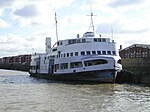Tate Institute
Buildings and structures completed in 1887Buildings and structures in the London Borough of NewhamLondon building and structure stubs

The Tate Institute was a community facility established by Henry Tate in Silvertown in 1887.The building was established to create an apolitical and non-sectarian environment. The Institute closed in 1933 and the building was used as a local library until 1961. The institute was boarded up in 2011, but in April 2016 a group of artists took over the building establishing the "Craftory", to rehabilitate the building and create the “Silvertown ArtSpace” to provide a hub for a broad range of artistic and community activities.
Excerpt from the Wikipedia article Tate Institute (License: CC BY-SA 3.0, Authors, Images).Tate Institute
Parker Street, London Silvertown (London Borough of Newham)
Geographical coordinates (GPS) Address Nearby Places Show on map
Geographical coordinates (GPS)
| Latitude | Longitude |
|---|---|
| N 51.5024 ° | E 0.047 ° |
Address
Philippe House
Parker Street 7-13
E16 2DJ London, Silvertown (London Borough of Newham)
England, United Kingdom
Open on Google Maps









